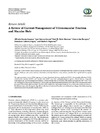Identificador persistente para citar o vincular este elemento:
https://accedacris.ulpgc.es/handle/10553/44503
| Campo DC | Valor | idioma |
|---|---|---|
| dc.contributor.author | García-Layana, Alfredo | en_US |
| dc.contributor.author | García-Arumí, José | en_US |
| dc.contributor.author | Ruiz-Moreno, José M. | en_US |
| dc.contributor.author | Arias-Barquet, Lluís | en_US |
| dc.contributor.author | Cabrera López, Francisco Antonio | en_US |
| dc.contributor.author | Figueroa, Marta S. | en_US |
| dc.date.accessioned | 2018-11-22T00:07:50Z | - |
| dc.date.available | 2018-11-22T00:07:50Z | - |
| dc.date.issued | 2015 | en_US |
| dc.identifier.issn | 2090-004X | en_US |
| dc.identifier.uri | https://accedacris.ulpgc.es/handle/10553/44503 | - |
| dc.description.abstract | The paper presents a review of the sequence of events of posterior vitreous detachment (PVD), vitreomacular adhesion (VMA), vitreomacular traction (VMT), and macular hole (MH) from their pathophysiological aspects, clinical features, diagnostic implications, and current management strategies. A treatment algorithm to be used in clinical practice in patients with VMA, VMT, and MH based on the presence of symptoms, visual acuity, associated epiretinal membrane, and width of the vitreous attachment is presented. Observation, pharmacologic vitreolysis with ocriplasmin, and surgical treatment are positioned as treatment options in the different steps of the therapeutic algorithm, with clear indications of the paths to be followed according to the initial presenting manifestations and the patient’s clinical course. | en_US |
| dc.language | eng | en_US |
| dc.publisher | 2090-004X | - |
| dc.relation.ispartof | Journal of Ophthalmology | en_US |
| dc.source | Journal of Ophthalmology [ISSN 2090-004X], v. 2015 (809640) | en_US |
| dc.subject | 320109 Oftalmología | en_US |
| dc.title | A review of current management of vitreomacular traction and macular hole | en_US |
| dc.type | info:eu-repo/semantics/article | es |
| dc.type | Article | es |
| dc.identifier.doi | 10.1155/2015/809640 | - |
| dc.identifier.scopus | 84925435368 | - |
| dc.contributor.authorscopusid | 6701529268 | - |
| dc.contributor.authorscopusid | 7004430969 | - |
| dc.contributor.authorscopusid | 35508307200 | - |
| dc.contributor.authorscopusid | 55581374800 | - |
| dc.contributor.authorscopusid | 35195300300 | - |
| dc.contributor.authorscopusid | 7102732255 | - |
| dc.identifier.issue | 809640 | - |
| dc.relation.volume | 2015 | - |
| dc.investigacion | Ciencias de la Salud | en_US |
| dc.type2 | Artículo | en_US |
| dc.identifier.ulpgc | Sí | es |
| dc.description.jcr | 1,463 | |
| dc.description.jcrq | Q3 | |
| dc.description.scie | SCIE | |
| item.fulltext | Con texto completo | - |
| item.grantfulltext | open | - |
| crisitem.author.dept | GIR SIANI: Ingeniería biomédica aplicada a estimulación neural y sensorial | - |
| crisitem.author.dept | IU Sistemas Inteligentes y Aplicaciones Numéricas | - |
| crisitem.author.dept | Departamento de Ciencias Médicas y Quirúrgicas | - |
| crisitem.author.orcid | 0000-0002-5074-5102 | - |
| crisitem.author.parentorg | IU Sistemas Inteligentes y Aplicaciones Numéricas | - |
| crisitem.author.fullName | Cabrera López, Francisco Antonio | - |
| Colección: | Artículos | |
Citas SCOPUSTM
49
actualizado el 08-jun-2025
Citas de WEB OF SCIENCETM
Citations
41
actualizado el 08-jun-2025
Visitas
104
actualizado el 12-oct-2024
Descargas
109
actualizado el 12-oct-2024
Google ScholarTM
Verifica
Altmetric
Comparte
Exporta metadatos
Los elementos en ULPGC accedaCRIS están protegidos por derechos de autor con todos los derechos reservados, a menos que se indique lo contrario.
